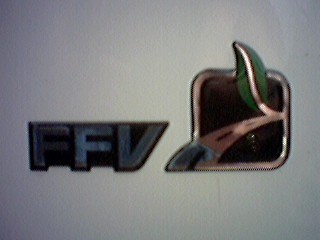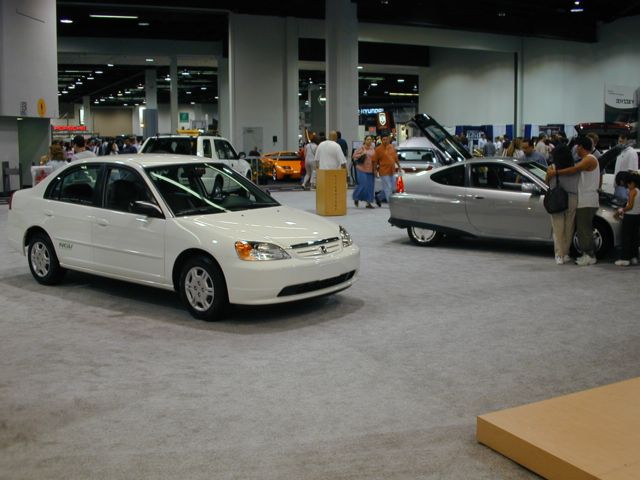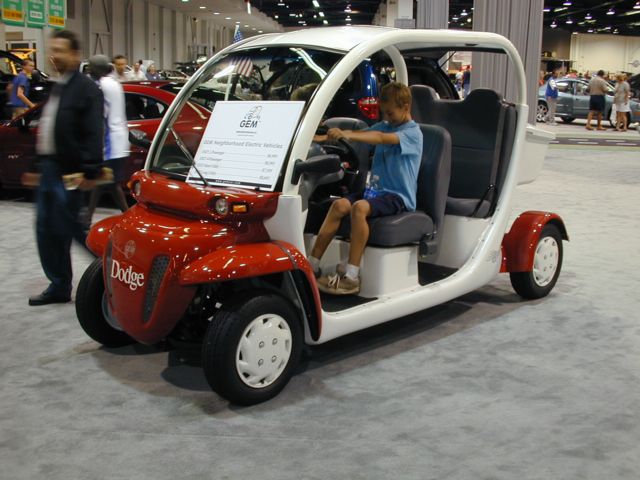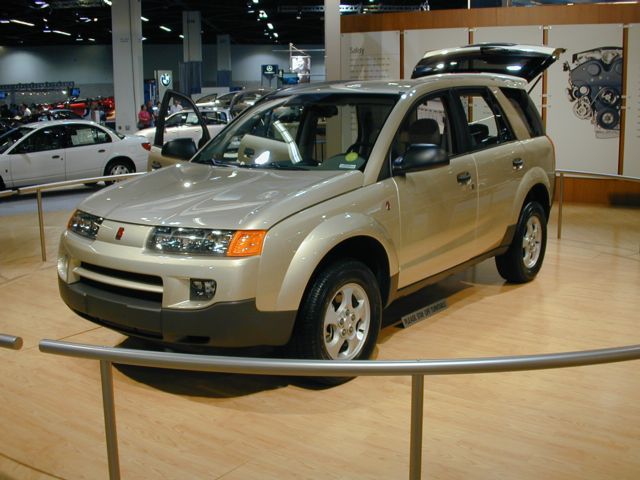
Home - AFV Events - Auto Shows - 2002 Anaheim Auto Show
Anybody who looks closely at the What's New page of this website will note that I haven't posted any new pages in almost a year. The reason is not lack of interest, but rather lack of time: since the last page was posted I have bought a house, moved in, and gotten married, and my new wife and I just hosted our first guests over Christmas! A few weeks before the wedding I slipped out to the California International Auto Show in Anaheim on 12 October 2001, and I'm finally stealing time to post a brief report on that.

If you look back at reports I've posted for auto shows over the past couple of years, you'll have noted that the pace of introduction of new alternative-fueled vehicles has slackened considerably since I began this website. Even so, this year's show was a big disappointment to me, since it is the first auto show I've attended since 1996 where I didn't find the General Motors EV1 battery-electric car in the Saturn display area. I also went looking for the Ford "Leaf and Road" logo pictured above (which I photographed with a low-resolution eyemodule camera in another city, not on a vehicle displayed at the show), and I found neither it nor any ethanol flex-fuel vehicles, though I understand that all the Big Three U.S. automakers are still building them.

Honda is still building the natural-gas-fueled Civic GX, here on display next to their hybrid-electric Insight. The Civic GX now comes standard and the Insight comes optionally with a continuously-variable transmission (CVT), which "shifts" more efficiently than a conventional automatic transmission; the EPA fuel economy of the CVT Insight is 57 MPG city and 56 MPG highway, compared to 61/68 MPG for the manual-transmission model. Note that, like the Toyota Prius hybrid with economy of 52/45 MPG, the CVT Insight gets better city than highway fuel economy; this takes some getting used to, but is a sign of the hybrid's ability not to waste gas sitting at idle (its engine shuts off, then restarts instantly when needed). I'm a little puzzled by the much lower highway fuel economy of the CVT Insight compared with the manual model; perhaps the CVT is more efficient than an ordinary automatic transmission around town when a lot of shifting is required, but at steady highway speeds it still loses out to a manual. (I have also read that the extra-efficient lean-burn engine is used in the manual-transmission but not the CVT version of the 2002 Insight; this doubtless has something to do with it too.) In any case, I'm still waiting to find out if the hybrid Civic, due out in early 2002, will offer the GX's natural-gas engine as an option!

One new alternative-fueled vehicle available this year is also a new kind: this is the GEM (Global Electric Motorcars) four-seater, a Neighborhood Electric Vehicle (NEV) or Low-Speed Vehicle (LSV) available from DaimlerChrysler dealers (note the Dodge logo on the nose, though I think that was just for display at this show). An LSV is a new class of vehicle defined by the Department of Transportation; it meets a set of Federal safety standards for things like lights, seatbelts, etc., has a top speed of 25 MPH or less, and is legal in many states on roads with a speed limit of 35 MPH or less, and an NEV is simply an electric LSV. Ford also has an NEV available through its dealers, the TH!NK Neighbor, as well as the TH!NK City two-seater (but freeway-capable) urban EV (which will be available in the U.S. in 2002). Both NEVs and city EVs, not to mention the beautiful Corbin Sparrow, are attempts to build EVs based on how people actually drive their vehicles, namely mostly for commuting and errands, instead of trying to be "all things to all people" by engaging in an expensive quest for 100 mile range per charge. Since these vehicles cost less to build, the California Air Resources Board allows them to count as "partial credit" towards the upcoming Zero-Emission Vehicle mandates, in the hope that automakers be able to sell more of these less-expensive vehicles (GEM models range from seven to nine thousand dollars). I'm looking forward to seeing what variants of these vehicle types show up at the Los Angeles Auto Show in January 2002. (Kids seem to love 'em!)

And finally, here's an example of the "spinoff" benefits of research on alternative fuels: this is the upcoming Saturn VUE sport-utility vehicle. Not the whole vehicle, of course, but some components reflect lessons learned from this research. In particular, a conventional engine-driven power steering pump wastes a lot of power maintaining pressure and churning fluid while the vehicle is stopped, and so the VUE has an electrically-pressurized hydraulic (electrohydraulic) power-steering setup like that on the EV1 electric car. (It will also offer a CVT, for increased fuel economy.) One of the arguments in favor of research on electric vehicles, "way back when," was that the stringent requirements for efficiency on such vehicles would spur innovations that could then be fed back into the main product lines. Since a lot of work on electric motors, controllers, and batteries for EVs has been directly transferable to hybrid-electric vehicles, one might say that the commercially very successful Prius and Insight hybrids, as well as the forthcoming models from other automakers, are direct payoffs from these companies' efforts to design battery-electric vehicles! Now if only we can get some "trickle-down" benefits for battery EVs in the form of economies of scale for components shared with the hybrids...
 Back
to AFV Events Page
Back
to AFV Events Page Back
to Fueling Station
Back
to Fueling Station Site
Map
Site
Map Contact
Me
Contact
Me All content copyright 1998-2024 by Mark Looper, except as noted. Reuse of my copyrighted material is authorized under Creative Commons Attribution 4.0 International license (CC BY 4.0).
![]()
![]()
new 31 December 2001, revised 12 January 2002